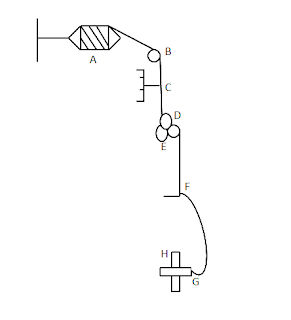TWISTING
Twisting is one of the main process carried out for man-made
fibers twisting induces the following advantages properties
(a) Increase in density and compactness
(b) Better appearance
(c) Higher breaking strength
(d) Imparting certain
properties like rigidity, flexibility, etc.
(e) improved resistance to
bending and wear
(f) Better processing
capacity
Type of twisted yarn
Twisted yams are generally
classified into three groups, as per the yam twisted. These will be
(i) low-twist yarn having
maximum of 230 twists per meter,
(ii) medium-twist yarn
having 230 to 900 twists per meter and
(iii) Hard twist yarn having
more than 900 twists per meter.
Type of twisting
The twists may be 'Z' twist
or 'S' twist as per the direction of the twists impart. Twisted yarns are
generally used in the following areas:
(i) in weaving and knitting,
(ii) For industrial purpose like ropes,
cable, cords, nets, etc,
(iii) For consumer goods like sewing threads,
embroidering twines etc.
The man-made fibers are
generally twisted in two stages. All the fiber plants performed the stretching
or drawing operation in a draw twisting machine. So a low twist is generally
applied to the parallel filaments in stretching operations. After this
operation, the filaments are delivered to the twisting department where medium
twisted and hard twist yams along with another type of twisted yarns are produced.
Type of twisting machine
The twisting can be done in any of the following machines.
(a) Ring twister
(b) Ringless twister
(c) Two for one twister
(c) Two for one twister
In-ring and ringless twister, the spindle may be single-twist spindles. Single process two-zone twisters are used to produce industrial twisted yams like tire cord.
RING TWISTING
The operation of
ring-twister is similar to that of the ring spinning. Ring-spinning is used
to perform drafting, twisting and winding whereas a ring-twister will perform
only twisting and winding. The principle of the operation is shown in Figure.
The supply package is placed
on the creel (a). The thread unwinds from the supply package, deflected its
motion by means of the guide rod (b), passes through the guide hook (c) and
enters the feeding device.
The feeding device generally
consists of three rollers connected with each other to grip the yan (d,e).
These three rollers consist of two cylinders and top rollers. From the feed
roller, the yarns pass through the guide hook (f), through the traveler (g)
and wound on the bobbin (h) placed on the spindle (i). Twisting is done by the
movement of the traveler and gripping of the feed roller.
Each revolution of the
traveler gives one twist to the yam, which is transferred up to the nipping
point. The total no. of twists depends upon the traveler speed or the
revolution. The exact amount of twist per cm is the ratio of the traveler
speed in rpm divided by the surface speed of the feed roller.
RINGLESS TWISTING
the principle to twist filaments by ringless twister is
similar in principle as that of the roving. In both cases a flyer is used
to collect the filament I instead of a ring and traveler. It is used only for
hard twists. The flyer may also be used for the supply package. The flow diagram of
a ringless twister or deck twister is shown in Fig
The supply package is fitted
on the spindle. The thread coming out from the supply package passes through
the edge of the flyer on the thread guide. The yarn passes from the thread
guide to an antiballooner guide and from it to the take-up bobbin through the
traverse guide.
The yarn comes from the supply package, fitted as a rotating spindle. So each rotation, the yarn will be twisted for one turn in the section between the supply package and the antiballooner.
The yarn comes from the supply package, fitted as a rotating spindle. So each rotation, the yarn will be twisted for one turn in the section between the supply package and the antiballooner.
TWO FOR ONE TWISTER
The efficiency of the
existing twisters can be considerably increased by using double-twist
principle. The general principle of this method is shown
Processing of fiber In an
ordinary twisting machine, one revolution of the spindle imparts one twist to
the yarn. So the number of twists per unit time is limited by the spindle speed
and the yam velocity. The maximum spindle speed is always restricted to 15,000
rpm. So the yarn velocity will be restricted to 60 m/min for a medium twist
yarn having 250 turns per meter. The twister is modified with a double twist
spindle. This ensures two twists per one revolution of the spindle. The system
increases the production rate.
The yarn is withdrawn from
the supply package through a yarm guide. The supply package is placed stationary on a hollow rotating
spindle.
The yarn moves downward
through the yarn guide to the hollow spindle. Further, it moves upward through a
yam outlet hole to the yarn take-up roller and then to the winding head. A
balloon separator is placed to avoid any
entanglement and frictional contact between the stationarý package and the
yarm.
The yarn coming out from the
package passes through the tension roller traverse guide and collected in the bobbin. Each revolution
of the spindle inserts one twist into the yam moving downward and another twist
into the yarn moving upward.
So simultaneously one
spindle revolution inserts two twists into the yam in the same direction. The
machine operates at a speed in the range of 10,000 rpm to 14,000 rpm with a
package weight of 3 kg. Each revolution inserts two tuns of twist and the
method of twist insertion does not involve high-speed rotation of the package.
So the machine has a relatively low power consumption.








